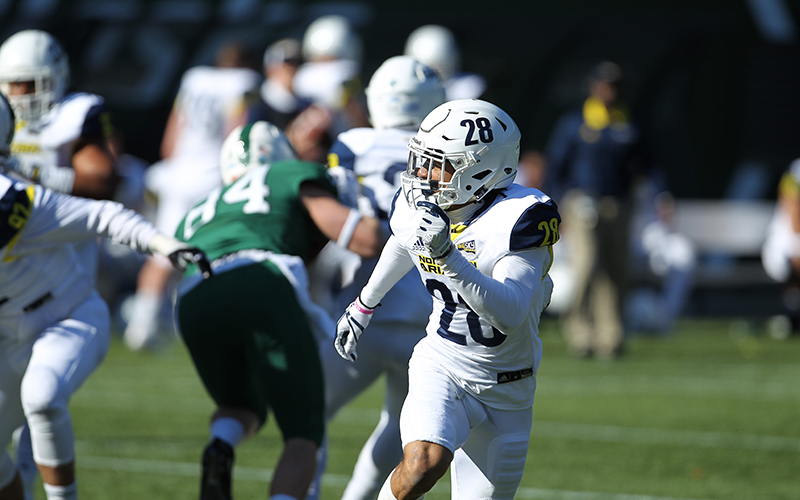
Although sprint football has traditionally been played at northeastern schools, a new league popping up in the Midwest suggests the possibility of the sport’s growth. (Photo by Oliver Morris/Getty Images)

Connor Majarucon (center) became a wide receiver for Navy sprint football after playing basketball at Greenway High School. He said the team’s tight-knit culture drew him in. (Photo courtesy of Connor Majarucon)
PHOENIX – Darrin Kenney had already seen a wide swath of the football world before 2015.
After getting his start at Division III Lycoming College in Pennsylvania, the lineman and two-time Arizona Rattlers captain played 10 seasons in the Arena Football League across four teams, coached for two more and broadcasted for yet another. He played with Jay Gruden, crossed paths with Kurt Warner and worked in concert with the Tennessee Titans. So Kenney was surprised when his old Lycoming teammate Mike Pearson told him about a domain of football that was totally unfamiliar.
Pearson had been hired as the football coach at Chestnut Hill College in Philadelphia, and he wanted Kenney to join his staff.
“They don’t have football at Chestnut Hill College,” Kenney responded.
Pearson corrected him: It wasn’t football, but sprint football.
“And I’m like, ‘Mike, what the hell is sprint football?’”
The answer, it turns out, is a brand of college football where it’s particularly hard to be a lineman like Kenney, because there’s a weight limit of 178 pounds (or 183 pounds with greater than 5% body fat). Otherwise, the game is the same.
“They played every bit as hard as anybody that I played with in college or the pros,” said Kenney, who ended up coaching offensive line for Chestnut Hill for five years. Many of his recruits ended up being undersized defensive linemen or linebackers who saw sprint football as a chance to keep playing a sport they loved – a great fit for Kenney, who had spent years coaching two-way players in arena football.
He said both football variations are similarly disregarded by the public. Although it isn’t sponsored by the NCAA, sprint football is a full-fledged varsity sport under the auspices of the Collegiate Sprint Football League. But Kenney’s initial lack of awareness wasn’t a surprise. The variant has been played among a single-digit number of exclusively northeastern schools for pretty much its entire 87-year history. Jimmy Carter played it at Navy, as did Robert Kraft at Columbia.

The Navy Midshipmen sprint football team is one of nine in the Collegiate Sprint Football League. In 2022, the number of schools playing the varsity sport will increase to 15, with the addition of six members of the Midwest Sprint Football League. (Photo courtesy of Connor Majarucon)
The recent announcement of a new midwestern league, set to begin play in 2022, provides optimism for the sport’s future expansion to the Southwest and beyond.
“If this gets picked up and is seen to be successful,” said Nancy Blattner, president of Fontbonne University and chair of the league’s Board of Governors, “I think it has legs, where it could translate into other parts of the country.”
Blattner is one of the principal architects of the Midwest league. On the advice of Chestnut Hill president Carol Jean Vale, Blattner previously implemented sprint football when she was at Caldwell University in New Jersey. She saw it as a “tremendous, tremendous boon” to the school: The sport allowed solid athletes who didn’t have the stature to compete in traditional football a chance to excel, and helped with gender balance and racial diversity at the university.
“We also saw that it would bring increased vibrancy to the campus community,” Blattner said, “because many high school students are familiar with and part of a football culture.”
When Blattner went to Fontbonne, in St. Louis, she bemoaned that she couldn’t join the league from there due to its geographical distance. Her husband told her she should start her own conference, which she initially thought was “snarky,” but came to realize was good advice.
Between the start of 2021 and the June announcement, Blattner gathered several schools, connected by geographic proximity and religious values, with plans for future expansion.
But why sprint football over football? For one thing, Blattner said she has CSFL data suggesting it leads to fewer concussions. (One of the member schools, Midway University, posted an FAQ on its site expressing the same sentiment.) In addition, Fontbonne is Division III in the NCAA and so cannot provide athletic scholarships for most sports, but it can give scholarships for sprint football. The new league includes schools from all three NCAA divisions, plus the NAIA. Quincy University does have both football and sprint football, which puts it in line with some CSFL schools such as Army and Navy.
The service academies have a rich history of sprint football. Connor Majarucon, a rising senior wide receiver at Navy who attended Greenway High School in Phoenix, learned about it during his “Plebe Summer” prior to entering the academy.
Even though he played basketball in high school, Majarucon immediately found himself drawn in by the culture of sprint football.
“They love what they do, not because they get a lot of awards or recognition from it,” he said, “but it’s just brothers that have grit, love working hard and love playing the game of football together.”
His new coach, Major Alfonso Meidus, a former Midshipmen sprint football running back, said this lack of desire for self-promotion may be the reason why sprint football has remained so insular.
“There’s not a big agenda to pack the stands,” he said, “and there’s not a big agenda to really get the name and the league out there.”
The new Midwest league provides a great opportunity to bring eyes to the sport, he added. Blattner also mentioned the prospect of an interleague competition. She said the presidents have a call planned in September to discuss a bowl game in Canton, Ohio – another place where there hasn’t been sprint football.
“It’s been so isolated over here,” Meidus said. “Now with the new league entering into the sport, I think you could really have an opportunity to publicize that game between the two leagues and make it really fun.”
If sprint football were ever to reach the Southwest, there would certainly be one intuitive choice of school. Meidus said that when he was a running back at Navy, he heard rumors about a third service academy, Colorado-based Air Force, potentially starting up sprint football. (Air Force spokesperson Troy Garnhart said there haven’t been any serious conversations about the sport during his lengthy tenure.)
Blattner said sprint football could take hold anywhere with enterprising university presidents who aren’t brought into conflict by competing for the same set of regional recruits. And while Kenney believes the stigma of the low weight limit has hurt sprint football, he agreed the sport has potential to expand, noting that there’s no shortage of players who get “sized out.”
“Now, if you’re not 300 pounds, if you’re not 6-foot-4… you don’t get the opportunity to play,” he said.
And with each new school that adopts sprint football, the likelihood of a bewildered reaction, like Kenney’s when he first learned about the sport, becomes just a little smaller.

